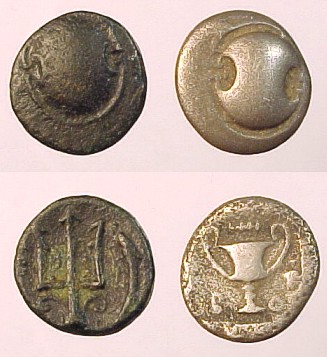Ancient Greek Money: In the initial period, the barter system prevailed in ancient Greece like all ancient civilizations. It was from 600 BC onwards that the Greek city-states began to make their own coins. By 500 BC, each city-state started minting its own coins.

Ancient Greek Money / Greek coins
Most of the Greek coins were silver. The coins were made by taking a small lump of silver and putting it on an iron mound and then stroke it with striking it with a hammer that had another kind of mound in it.Coins from the city-state of Athens sometimes had a picture of Athens owl on the silver coins.
Coins from the city-state of Corinth had in them the picture of the flying horse Pegasus. A tetra drachma discovered from 450 BC had Athena on one side and owl on the reverse.

Ancient Athenian Currency
Drachma was the Athenian currency. Because of the highly developed trade, the Athenian currency was popular and used widely. 6 obols were equal to 1 drachma and 100 drachma was equal to 1 mina. 1 talent was equal to 600 mines. Initially, a drachma was a grasp of 6 metal sticks. Drachma was used as early as 1100 BC. Drachmas were minted on different weight standards at different Greek mints.

A loaf of bread was priced 1 obol. The cost of a gallon of oil was 5 drachmas and that of a lamb was 8 drachmas. 200 to 300 drachmas was the cost of slaves. A typical worker earned 2 drachmas daily. Doctors and sculptures made 6 drachmas a day.
To exchange their coins, foreigners had to find a moneychanger. Five to six percent fee was charged to exchange foreign currency to the local currency. Notable Ptolemaic coins included the gold Pentadrachm and Octadrachm, and silver tetradrachm, decadrachm and Pentakaidecadrachm.